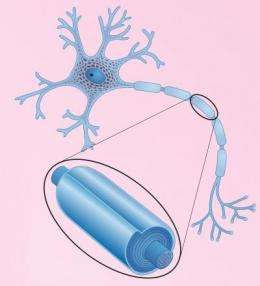New nanoscale imaging may lead to new treatments for multiple sclerosis

Laboratory studies by chemical engineers at UC Santa Barbara may lead to new experimental methods for early detection and diagnosis -- and to possible treatments -- for pathological tissues that are precursors to multiple sclerosis and similar diseases.
Achieving a new method of nanoscopic imaging, the scientific team studied the myelin sheath, the membrane surrounding nerves that is compromised in patients with multiple sclerosis (MS). The study is published in this week's online edition of the Proceedings of the National Academy of Sciences (PNAS).
"Myelin membranes are a class of biological membranes that are only two molecules thick, less than one millionth of a millimeter," said Jacob Israelachvili, one of the senior authors and professor of chemical engineering and of materials at UCSB. "The membranes wrap around the nerve axons to form the myelin sheath."
He explained that the way different parts of the central nervous system, including the brain, communicate with each other throughout the body is via the transmission of electric impulses, or signals, along the fibrous myelin sheaths. The sheaths act like electric cables or transmission lines.
"Defects in the molecular or structural organization of myelin membranes lead to reduced transmission efficiency," said Israelachvilli. "This results in various sensory and motor disorders or disabilities, and neurological diseases such as multiple sclerosis."
At the microscopic level and the macroscopic level, which is visible to the eye, MS is characterized by the appearance of lesions or vacuoles in the myelin, and eventually results in the complete disintegration of the myelin sheath. This progressive disintegration is called demyelination.

The researchers focused on what happens at the molecular level, commonly referred to as the nanoscopic level. This requires highly sensitive visualization and characterization techniques.
The article describes fluorescence imaging and other measurements of domains, which are small heterogeneous clusters of lipid molecules –– the main constituents of myelin membranes –– that are likely to be responsible for the formation of lesions. They did this using model molecular layers in compositions that mimic both healthy and diseased myelin membranes.
They observed differences in the appearance, size, and sensitivity to pressure, of domains in the healthy and diseased monolayers. Next, they developed a theoretical model, in terms of certain molecular properties, that appears to account quantitatively for their observations.
"The discovery and characterization of micron-sized domains that are different in healthy and diseased lipid assemblies have important implications for the way these membranes interact with each other," said Israelachvili. "And this leads to new understanding of demyelination at the molecular level."
The findings pave the way for new experimental methods for early detection, diagnosis, staging, and possible treatment of pathological tissues that are precursors to MS and other membrane-associated diseases, according to the authors.
Provided by University of California - Santa Barbara

















